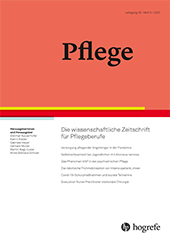Implementierung einer „Nurse Practitioner“-Rolle in der stationären Chirurgie
Eine Mixed-Methods-Studie mit Prä-post-Messung
Abstract
Zusammenfassung:Hintergrund: Die Studie beschreibt die Einführung und Erprobung einer Nurse-Practitioner-Rolle in der akutstationären Chirurgie in einem schweizerischen Krankenhaus über ein Jahr. Der Einsatz Nurse Practitioner kann die Kontinuität in der Betreuung, die Versorgungsqualität und die Patientensicherheit verbessern. Ziel: Aufgezeigt werden die kurzfristigen Ergebnisse einer solchen Rolle im stationär chirurgischen Bereich nach einem Jahr Laufzeit. Die Zielgrößen umfassten neun Messkriterien. Methode: Die Evaluation erfolgte mittels eines Mixed-Methods-Ansatzes, teilweise im Prä-post-Vergleich. Quantitativ wurden Anzahl betreute Patient_innen, Austrittszeit, interprofessionelle Zusammenarbeit, Liegedauer, Störungen im Alltag und die Verfügbarkeit der Austrittsdokumente erfasst. Die qualitative Erfassung beinhaltete das Erleben der Beteiligten. Ergebnisse: Die Ergebnisse der Evaluation weisen auf einen Mehrwert durch die neue Rolle hin. Hinweise finden sich in der Betreuungskontinuität und Zugänglichkeit in medizinischen Fragen der Beteiligten sowie in der Optimierung der Patient_innenprozesse. Erschwerend erwies sich die gesetzlich ungeklärte Situation in der Schweiz. Schlussfolgerungen: Die Stärke dieser Rolle lag in der Erhöhung der Betreuungskontinuität, der Verbesserung der Ansprechbarkeit in medizinischen Fragen für Patient_innen und Pflegende sowie in der Optimierung der Patientenprozesse und damit auch der Patientensicherheit. Die gesetzlichen Vorgaben bezüglich der Kompetenzen erschweren derzeit den Einsatz von Nurse Practitioner im stationären Bereich.
Abstract:Background: The study describes the introduction and testing of a Nurse Practitioner role in acute inpatient surgery in a Swiss hospital over a year. Using a Nurse Practitioner can improve continuity of care, quality of care and patient safety. Aim: The short-term outcome of such a role in the field of inpatient surgery is shown after one year. The target variables included nine measurement criteria. Method: The evaluation was carried out using a mixed-method approach, partly in a pre-post comparison. Quantitatively, the number of patients being looked after, the discharge time, interprofessional cooperation, the duration of stay, disruptions to everyday life and the availability of the discharge documents were recorded. The qualitative recording included the experience of the participants. Results: The results of the evaluation indicate an added value of the new role. Indications can be found in the continuity of care and amenability in medical issues of the participants, as well as in the optimization of patient processes. The legally undefined situation in Switzerland proved to be difficult. Conclusions: The strengths of this role were increasing continuity of care, improving responsiveness in medical issues for patients and caregivers, as well as optimizing patient processes and patient safety. The legal requirements regarding competencies currently make it difficult to use NPs in the inpatient sector.
Literatur
(2016). Framework for Evaluating the Impact of Advanced Practice Nursing Roles. J Nurs Scholarsh , 48 (2), 201–209. https://doi.org/10.1111/jnu.12199
(2004). A framework for the introduction and evaluation of advanced nursing practice roles. 530 – 540.
(2010). Advanced practice nursing in Canada: overview of a decision support synthesis. Nurs Leadersh (Tor Ont) , 23 Spec No 2010 , 15–34. https://doi.org/10.12927/cjnl.2010.22267
(2017). Impact of adding additional providers to resident workload and the resident experience on a medical consultation rotation. BMC Med Educ , 17 (1), 44. https://doi.org/10.1186/s12909-017-0874-7
(2014). Advanced practice nursing: an integrative approach (5th ed.). Elesevier Saunders.
(2017). An Outcome Analysis of Nurse Practitioners in Acute Care Trauma Services. Journal of Trauma Nursing , 24 (6), 365–370. https://doi.org/10.1097/JTN.0000000000000327
(2016). Outcomes of Nurse Practitioner-Delivered Critical Care: A Prospective Cohort Study. Chest , 149 (5), 1146–1154. https://doi.org/10.1016/j.chest.2015.12.015
(2011). Physician assistant and nurse practitioner utilization in academic medical centers. American Journal of Medical Quality , 26 (6), 452–460. https://doi.org/10.1177/1062860611402984
(2017). Association between advanced practice nursing and 30-day mortality in mechanically ventilated critically ill patients: A retrospective cohort study. Journal of Critical Care , 41 , 209–215. https://doi.org/10.1016/j.jcrc.2017.05.025
(2021). Effectiveness of the Advanced Practice Nursing interventions in the patient with heart failure: A systematic review. Nurs Open , 8 (4), 1879–1891. https://doi.org/10.1002/nop2.847
(2018). Gezielte Entwicklung von Advanced Practice Nurse-Rollen fur spezifische Patient(inn)engruppen in einem Schweizer Universitatsspital. Pflege , 31 (1), 41–50. https://doi.org/10.1024/1012-5302/a000594
(2010). 10 Jahre Advanced Nursing Practice in der Schweiz: Rückblick und Ausblick. Pflege , 23 (6), 363–373. https://doi.org/https://doi.org/10.1024/1012-5302/a000075



